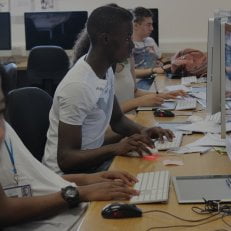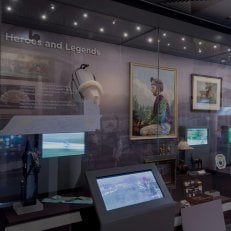Things to consider before an NLHF application
For Day 2 of #CraigmyleNLHFweek we are looking at NLHF project development. The importance of ‘preparing the ground’ for an NLHF project cannot be overestimated. In fact, the development work is arguably more important than the bid writing itself. There is an enormous amount of work that needs to be done before you are ready to sit down and write your application. Our advice is: “be like Mozart”. Compose the symphony in your head first; writing it down will then flow all by itself!

Conceiving your project, agreeing the scope, engaging partners and developing your case, are crucial stages your organisation needs to work through before applying. From the start you’ll need to keep the 4 Investment principles in mind. Saving Heritage; Protecting the Environment; Organisational Sustainability and Inclusion access and Participation. Make sure to address all four, but it’s reasonable to assume that every project, depending on cost and purpose, will naturally lean more towards one of those four.
Every project is different, but there are some common features that should be part of a successful NHLF project development process (and which in turn might increase your chances of a successful application).
Agreeing the scope: Think about how aspirational your project should be. How bold and ambitious are you prepared to be? It can feel daunting to start a process such as this. Your charity might never have undertaken a project on this scale before. Are you up to it? The Heritage Fund’s strategy 2023-33 is introducing a new Investment Principle specifically focussed on organisational resilience. They want to feel confident that the applicant is capable of managing a project of this scale. Therefore, at an early stage, think carefully about whether you have the required skills, experience and expertise in-house or if you should seek support from outside consultancies. Consider also whether an application as a partnership might have benefits. Ultimately your organisation should come out of this process with increased commercial and governance capabilities.
Evidence of Need: Make an inventory of the needs you want to address. This involves your audience. It requires asking the people who will benefit from your project what their needs are and how they could be met. It is crucial to start these conversations as early as possible.
Undertaking a thorough community consultation is the pivotal part of your project development. Remember that it isn’t just a one-way street. Apart from asking what and where the needs are, you should also look for ways in which your beneficiaries can take ownership; how they can be involved in the creation of your project.
You are entirely free to decide what shape the consultation will take. Often charities email surveys and questionnaires to their service users and distribute via social media. But you could also think about interviewing beneficiaries face to face (door-to-door), or hosting events and/or focus groups. However you do it, the important part is that you gather both qualitative and quantitative data and record the feedback.
When you produce your consultation report, don’t forget to include some research on the local population and geographical location. Provide data on the area where your project will take place. Include information about the local population, demographics, levels of deprivation, and any heritage significance in the area. This research helps contextualise the need for your project.
Partnerships: Evidence gathered from your beneficiaries should be accompanied by evidence of support from your partners. The more letters of support from committed partners you can submit the better. The same applies to other stakeholders including voluntary and community groups, local, schools, and youth organizations, the local authority, your local MP.
As said before; it might be beneficial to enter into the application process as a partnership. Two organisations working together have twice the reach, twice the resources, twice the number of contacts and beneficiaries. But even when you undertake this project on you own, you’ll still need partners. The buy-in from local partners lends weight to your argument.
Case Development: Armed with both qualitative and quantitative data from your consultation, you can further develop your case. Essentially this means you’ll be formulating the rationale of your project. A compelling and persuasive narrative will meet the NLHF Investment Principles and answer the key questions: Why is it necessary? Who will benefit? How are we incorporating community and volunteering activity? Which partners, service providers and service users are going to help us implement all this? And crucially: How much is all of this going to cost? (bear in mind of course that it will be too early at this stage to have your budget nailed down to the last penny).
It is advisable to start thinking about evaluation as part of your NHLF project development. Starting your evaluation early is always a good thing. The obvious advantage is that the evaluator can be involved in the design of the process from the start, helping you decide what you need to measure; what your baseline is; what evidence you can use to show change and what tools you will use.
Reports, studies, appraisals, surveys: This is also the stage where you will commission specialists to produce the necessary plans, reports, surveys and appraisals. Depending on your project (and whether your application is for 1 stage; below £250k or 2 stages), you might need planning permission/ faculty, architectural designs or options appraisals, heritage statements, feasibility studies, market research and business plans. You’ll need to demonstrate that you have considered the impact of your project on the climate and the environment through environmental impact reports and/or eco audits.
The various specialist permissions and reports are necessary but can be expensive. Don’t forget that even for this early development work funding could be available. The Architectural Heritage Fund, for example offers Project Viability Grants for early-stage feasibility work.
Other funding: Whether a one stage or two stage process, NLHF will never fund 100% of your project cost. As part of your NHLF project development you’ll therefore need to start thinking about where the rest of your money is going to come from. A fundraising consultant can help you with a strategy for planning a campaign that covers all your constituencies, individual giving, corporate partners, trusts & foundations and statutory sources.
Applying to NLHF really is a symphony! We need to understand our audience. We can’t all be Mozart, but there are lessons in the way he prepared. He created stories by assembling all the constituent parts and made them fit; made them work together in harmony. And only when the story was complete, and made perfect sense in his head, did he write it down.
*
CraigmyleNHLFweek
Day1 https://www.craigmyle.org.uk/tips-and-blogs/the-evolving-role-of-national-heritage-lottery-fund/





